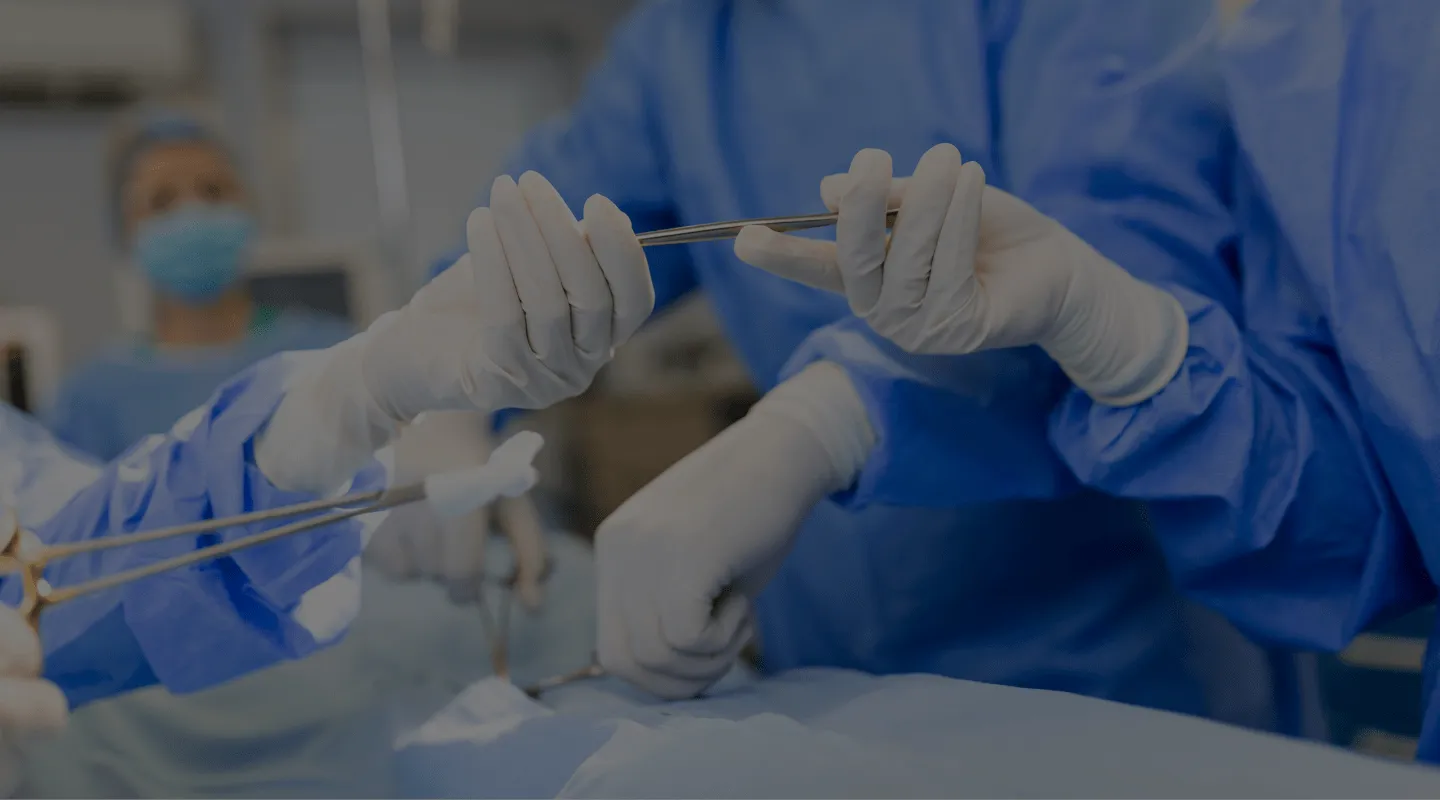
Testicular Biopsy
Your Testicular Biopsy in Tunisia at an Affordable Price
Benefit from a thorough diagnosis thanks to a testicular biopsy performed in the most modern clinics.
How does it work?
Testicular Biopsy: What is it?
A testicular biopsy involves directly collecting sperm from the testicles for use in Assisted Reproductive Technology (ART) cycles such as IVF or ICSI. The collected sperm can be used immediately or frozen for a future ART cycle.
When is a testicular biopsy performed for IVF or ICSI?
Testicular biopsy is performed in the following cases:
- Azoospermia: no sperm in the ejaculate;
- Oligoasthenoteratospermia: altered quality of ejaculated sperm that has not led to success after several ART cycles;
- Blockage: inability to collect sperm by masturbation due to various reasons (blockage, discomfort, etc.);
How is a testicular biopsy performed?
A testicular biopsy is performed under general anesthesia by a urological surgeon. It is an outpatient procedure. The surgeon makes an incision in the skin of the scrotum to expose the testicles. Small incisions are then carefully made in the testicles to collect testicular tissue, which is transferred to the laboratory of our assisted reproduction center. Once the sample is collected, the testicles are returned to the scrotum, and the skin is carefully closed.
What is the cost of a testicular biopsy in Tunisia?
The price of a testicular biopsy starts from €1000. To receive a personalized quote for an affordable testicular biopsy, please contact us. Tunisia Destination Santé can offer packages including all medical fees, such as the price of the entire IVF cycle, as well as additional examinations or procedures such as testicular ectopia, embryo freezing, etc. TDS can also offer accommodation packages to suit your budget.
Why opt for a testicular ultrasound?
An ultrasound is often the first test performed if your doctor thinks you might have testicular cancer. It uses sound waves to produce images of the inside of your body. It can be used to see if a change is a benign condition (such as a hydrocele or varicocele) or a solid mass that could be cancer. If the mass is solid, it is more likely to be cancer. In that case, your doctor may suggest further tests or even consider surgery to remove the testicle, if necessary.
How can blood tests help diagnose testicular tumors and determine their type?
Certain blood tests can be used to detect testicular tumors. Many types of testicular cancer are known to produce high levels of specific proteins called tumor markers, such as alpha-fetoprotein (AFP) and human chorionic gonadotropin (HCG). The presence of these markers in the blood suggests the presence of a testicular tumor.
- To better understand the type of testicular cancer, doctors can assess the levels of AFP or HCG that are elevated;
- Non-seminomas often increase AFP and/or HCG levels;
- Pure seminomas occasionally increase HCG levels but never AFP levels;
This means that any increase in AFP is a sign that the tumor has a non-seminomatous component. (Tumors can be mixed and have areas of seminoma and non-seminoma.) Sertoli and Leydig cell tumors do not produce these substances. It is crucial to emphasize that, in some cases, tumor hormones may not be elevated if the tumor size is too small. Moreover, in the case of testicular tumors, an enzyme called lactate dehydrogenase (LDH) may increase tumor levels. However, it should be noted that a high level of LDH does not always mean widespread disease. But, LDH levels can also be increased with certain non-cancerous conditions. Tumor marker tests can have different uses, such as helping to assess the severity of cancer (see the section “Stages of testicular cancer”), measuring treatment effectiveness, or detecting a possible recurrence.
Why is a biopsy rarely used to diagnose testicular cancer?
To detect cancer cells, a small sample of the tumor is usually taken and observed under a microscope, in a process called a biopsy. However, this procedure is rarely used for testicular tumors because it carries a risk of spreading the cancer. To determine if it is testicular cancer, the doctor can often use ultrasound and blood tumor marker tests. Instead of performing a biopsy, the doctor will generally opt for surgery (such as radical inguinal orchiectomy) to quickly remove the tumor. For an accurate diagnosis, the entire testicle is sent to a laboratory where a pathologist, a doctor specializing in detecting diseases in a laboratory, carefully examines samples of the tumor under a microscope. If cancer cells are detected, the pathologist writes a report detailing the type and extent of the disease.
To ensure an accurate diagnosis of testicular cancer, a doctor may perform a biopsy of the testicle before removal in very rare circumstances. This is done in the operating room. The surgeon makes an incision above the pubic region and removes the testicle from the scrotum to examine it without cutting the spermatic cord. If a suspicious area is identified, a sample is taken and examined immediately by the pathologist. If cancer is detected, the testicle and spermatic cord are then removed. When the tissue shows no signs of cancer, the testicle can be easily put back into the scrotum. However, if testicular cancer is detected, your doctor will order imaging tests of other parts of your body to check if the disease has spread outside the testicle. These tests can also be performed before any surgery to confirm the diagnosis.
Why perform imaging tests after testicular cancer?
Imaging tests use various techniques such as X-rays, magnetic fields, sound waves, or radioactive agents to obtain images of the inside of your body. The testicular ultrasound mentioned above is a specific form of this examination. Other imaging tests can be performed for a number of reasons after a diagnosis of testicular cancer, including:
- To find out if and how far the cancer has spread;
- To help determine if the treatment has worked;
- To look for any signs of cancer recurrence after treatment;
What is the post-operative care after a testicular biopsy?
A testicular biopsy is a minor surgical procedure that involves removing a small sample of testicular tissue through a small incision in the scrotum. After surgery, you may experience mild pain and swelling in the scrotum, which can be relieved with pain relievers and ice. For quick healing without complications, it is advisable to avoid physical and sexual activities for a few days after the procedure. Biopsy results can be obtained within days of surgery and help detect any abnormalities in testicular tissue.
What are the results of a testicular biopsy in Tunisia?
A testicular biopsy is an important procedure to analyze testicular tissue and determine the presence of sperm. The results are usually obtained within a few days. If sufficient sperm production is present, it can be used in assisted reproductive techniques such as in-vitro fertilization or intracytoplasmic sperm injection. However, if sperm production is insufficient, it may indicate permanent infertility. To better understand the results of the testicular biopsy and consider therapeutic options, it is essential to discuss this with your doctor. Depending on the situation, it is possible to consider alternatives such as sperm donation or adoption. Talk to your doctor for an informed decision.
Our advantages


Contact and quote request for a testicular biopsy
If you are considering going to Tunisia for a testicular biopsy, you can contact us. Tunisia Destination Santé will assist you in preparing your IVF file and organizing your stay.
Your health, our priority.
Request your free quote.
Frequently Asked Questions
There are two main types of testicular biopsy: needle biopsy (percutaneous biopsy) and open testicular biopsy (surgical biopsy). Needle biopsy is generally used for infertility investigations, as it is less invasive. Open biopsy is recommended when a testicular abnormality is detected by imaging or when a needle biopsy has not provided sufficient information.
Potential risks of a testicular biopsy include infection, bleeding, hematoma, pain, and in rare cases, testicular damage that can affect sperm production. However, these complications are relatively rare, and the procedure is generally considered safe.
A testicular biopsy allows examination of testicular tissue to detect abnormalities in sperm production. This can help identify conditions such as obstructive azoospermia (blockage preventing sperm release) or non-obstructive azoospermia (failure to produce sperm), thus determining the appropriate treatment.
A testicular biopsy may be necessary in the presence of suspicious testicular masses, abnormalities detected by imaging, unexplained low sperm count, or to determine the cause of unexplained infertility after other preliminary tests.
Before a testicular biopsy, it is important to follow your doctor’s instructions, which may include stopping certain medications, fasting before the procedure, and taking specific hygiene measures. It is also recommended to discuss medical history and any allergies with the doctor.
A testicular biopsy, especially open biopsy, can cause scarring or damage to testicular tissue, which could potentially affect sperm production. However, the risks of permanent damage are low, and most men do not experience significant changes in their fertility.
Recovery after a testicular biopsy is generally quick. Most men can resume light activities within 1 to 2 days, and more strenuous activities, including sexual intercourse, after about a week. It is important to follow your doctor’s recommendations to avoid complications.
Testicular biopsy is rarely used to diagnose testicular cancer because ultrasound and blood markers are usually sufficient. However, it can be used to confirm a diagnosis in ambiguous cases or to determine the exact type of testicular tumor in order to plan the most effective treatment.
Under local anesthesia, the scrotal area is numbed to minimize pain. The doctor makes a small incision or uses a needle to take a sample of testicular tissue. The procedure is relatively quick, and patients can usually go home the same day.
Alternatives to testicular biopsy include blood tests for tumor markers, testicular ultrasounds, and semen analysis. These non-invasive tests can provide valuable information about testicular health and help diagnose conditions without requiring surgery.
